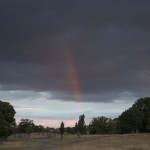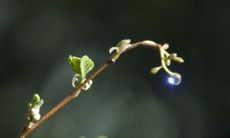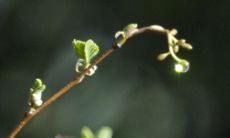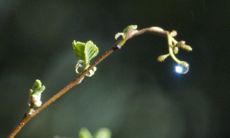I took this short sequence in the garden this afternoon. No photo-shopping, just a nice illustration of the splitting of sunlight into it’s component colors by refraction through a water drop – shuddering in the breeze after a storm.
 The simplest of things, it put me in mind of John Keats’s supposed lament that Isaac Newton had destroyed the beauty of the rainbow by explaining the science behind it, the underlying sentiment of which he included in the poem Lamia. I say supposed, because I can’t find a primary reference to Keats actually ‘having a go’ at Newton over his prism or whatever. Lamia however speaks for itself (see below).
The simplest of things, it put me in mind of John Keats’s supposed lament that Isaac Newton had destroyed the beauty of the rainbow by explaining the science behind it, the underlying sentiment of which he included in the poem Lamia. I say supposed, because I can’t find a primary reference to Keats actually ‘having a go’ at Newton over his prism or whatever. Lamia however speaks for itself (see below).
 Richard Dawkins gives an alternative view in his book, Unweaving the Rainbow, where he argues scientific understanding enhances rather than diminishes beauty. I’m with Dawkins on this one. And while those going through life without a scientific education (for whatever reason) experience it in a way that is different, I believe they are also simply missing out.
Richard Dawkins gives an alternative view in his book, Unweaving the Rainbow, where he argues scientific understanding enhances rather than diminishes beauty. I’m with Dawkins on this one. And while those going through life without a scientific education (for whatever reason) experience it in a way that is different, I believe they are also simply missing out.
Keats’s rainbow reference appears in his poem Lamia Part II:
What wreath for Lamia? What for Lycius?
What for the sage, old Apollonius?
Upon her aching forehead be there hung
The leaves of willow and of adder’s tongue;
And for the youth, quick, let us strip for him
The thyrsus, that his watching eyes may swim
Into forgetfulness; and, for the sage,
Let spear-grass and the spiteful thistle wage
War on his temples. Do not all charms fly At the mere touch of cold philosophy?
There was an awful rainbow once in heaven:
We know her woof, her texture; she is given
In the dull catalogue of common things.
Philosophy will clip an Angel’s wings,
Conquer all mysteries by rule and line,
Empty the haunted air, and gnomed mine—
Unweave a rainbow, as it erewhile made
The tender-person’d Lamia melt into a shade.



